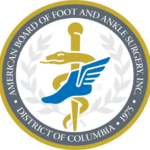Common Foot & Ankle Conditions
COMMON FOOT & ANKLE CONDITIONS
Achilles Tendinitis
The Achilles Tendon is the largest tendon in the body and connects the calf muscle to the back of the heel bone. Tendinitis is characterized by inflammation of the tendon. Usually, Achilles tendinitis is not related to one specific injury, but rather, from repetitive stress to the tendon like running or jumping.
Ankle Sprain
An ankle sprain occurs when the strong ligaments that support the ankle stretch beyond their limits and tear. They can range from mild to severe, depending on how much damage there is to the ligaments. It is important to see a podiatrist if you suspect an ankle sprain to prevent further damage or chronic pain/weakness.
Athletes Foot
Athletes foot is a common, contagious fungal infection that affects the skin on the feet. It can spread to the toenails and hands if left untreated. The fungal infection is called “athletes foot” because it is commonly seen in athletes.
Bone Spurs
A bone spur is an outgrowth of bone that can occur along the edges of a bone. Bone spurs are caused by abnormal bone growth or imperfect bone remodeling in response to pressure, tension or trauma. Bone spurs in the foot most frequently occur in the heel bone (calcaneus), in the ankle joint after a fracture, or on the top of the foot.
Bunions
Bunions form when the bone or tissue at the joint at the bottom of the big toe moves out of place. Years of abnormal motion and pressure on the joint forces the big toe to bend toward the others, which causes an often-painful lump on the joint.
Children
Children are prone to a variety of foot conditions such as: Warts, Ingrown nails, Athletes foot, Flat feet, Toe walking/in-toeing, Severs disease (heel pain that occurs because of inflammation of the growth plate) The final closure of the growth plates in the feet does not occur until between 18-20 years of age.
Diabetic Foot Ulcer
A diabetic foot ulcer is an open sore or wound that is most commonly located on the bottom of the foot or toes. Approximately 15% of patients with diabetes, develop a diabetic foot ulcer. Anyone who has diabetes can develop a foot ulcer, however, patients who use insulin or have continuous uncontrolled blood sugars are at higher risk.
Drop Foot
Drop Foot is a gait abnormality that is normally caused from nerve damage. The effected foot has decreased or no strength to perform dorsiflexion (the motion of bending at the ankle to bring the toes up). Drop foot causes difficulty walking and can cause tripping and falling.
Flat Foot
Flatfoot is often a complex disorder, with diverse symptoms and varying degrees of deformity and disability. There are several types of flatfoot, all of which have one characteristic in common: partial or total collapse (loss) of the arch. Other characteristics shared by most types of flatfoot include toe drift, in which the toes and front part of the foot point outward.
Fractures
Fractures are characterized by a crack or break in the bone normally caused by injury but can also be a result of chronic stress to the bone or poor bone health. Fractures are treated based on the severity and type of fracture.
Ganglion Cysts
Ganglion cysts are benign, fluid-filled, soft-tissue masses. The most distinguishing feature of these cysts is that they mostly appear around joints and tendons, but on rare occasions appear in bones or tendons. They are often painless and harmless, but as with any growth, you should see a podiatrist to rule out any serious issues.
Hammertoes
A Hammertoe is a contracture (bending) of one or both joints of the toes. This abnormal bending can cause pain and pressure on the toe with shoes and while walking. Hammertoes usually start out as mild deformities and get progressively worse over time.
Heel Pain/Plantar fasciitis
The most common cause of heel pain is plantar fasciitis. The plantar fascia is a ligament that stretches from the base of the toes to the heel bone and makes up the arch. When this ligament becomes inflamed, it pulls on the heel bone, causing pain to the heel. When left untreated, chronic plantar fasciitis can heel spurs to develop.
Ingrown Toenails
An Ingrown toenail is a common condition in which the corner of the toenail grows into the flesh and can cause pain, redness, and infection. Typically, ingrown nails affect the big toe, however any of the toenails can be affected.
Nail Fungus
A fungal infection of the toenails or fingernails is caused by a fungal microbe that invades the nail bed. Toenail fungus is often contracted from infected shoes or walking barefoot in contaminated areas. The fungus can cause the toenail to become thick, brittle, and discolored.
Neuroma
A neuroma is a benign growth of nerve tissue that is commonly found between the third and fourth toes. When the nerve becomes inflamed, it can cause pain, a burning sensation, tingling, or numbness between the toes and in the ball of the foot.
Neuropathy
Neuropathy is a condition that happens when nerves that carry messages to and from the brain and spinal cord from the rest of the body are damaged or diseased. This can happen for various reasons. One of the leading causes of neuropathy seen in podiatry is diabetes.
Posterior Tibial Tendonitis
Posterior tibial tendinitis is a condition caused by changes in the tendon that works to hold up the arch of the foot. These changes can be caused by an acute injury, overuse, or prolonged strain on the tendon. If left untreated, the arch can fall causing the foot to flatten.
Skin Cancer
Skin lesions can appear anywhere on the body. When these lesions appear on the feet, ankles or lower legs, your podiatrist can examine them and remove them for biopsy if necessary. Your podiatrist may be able to spot a lesion that you may have never noticed, such as on the bottom of your foot. When detected early, skin cancer can be treated much more effectively and conservatively.
Tarsal Tunnel Syndrome
Tarsal tunnel syndrome is a compression, or squeezing, on the posterior tibial nerve. This compression causes pain anywhere along the path of the nerve running from the inside of the ankle into the foot. Tarsal tunnel syndrome is similar to carpal tunnel syndrome, which occurs in the wrist. Both disorders happen because of compression of a nerve in a small space.

